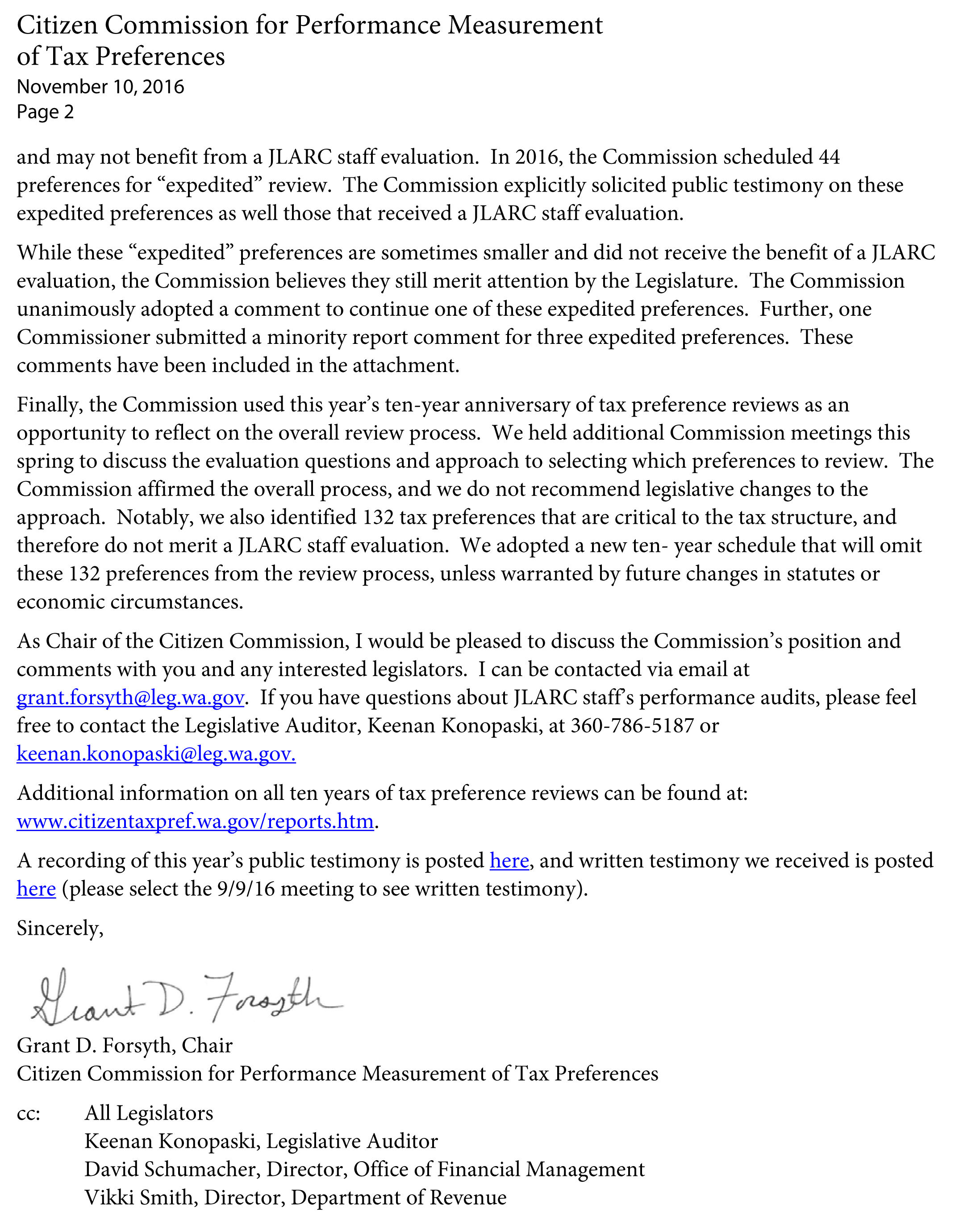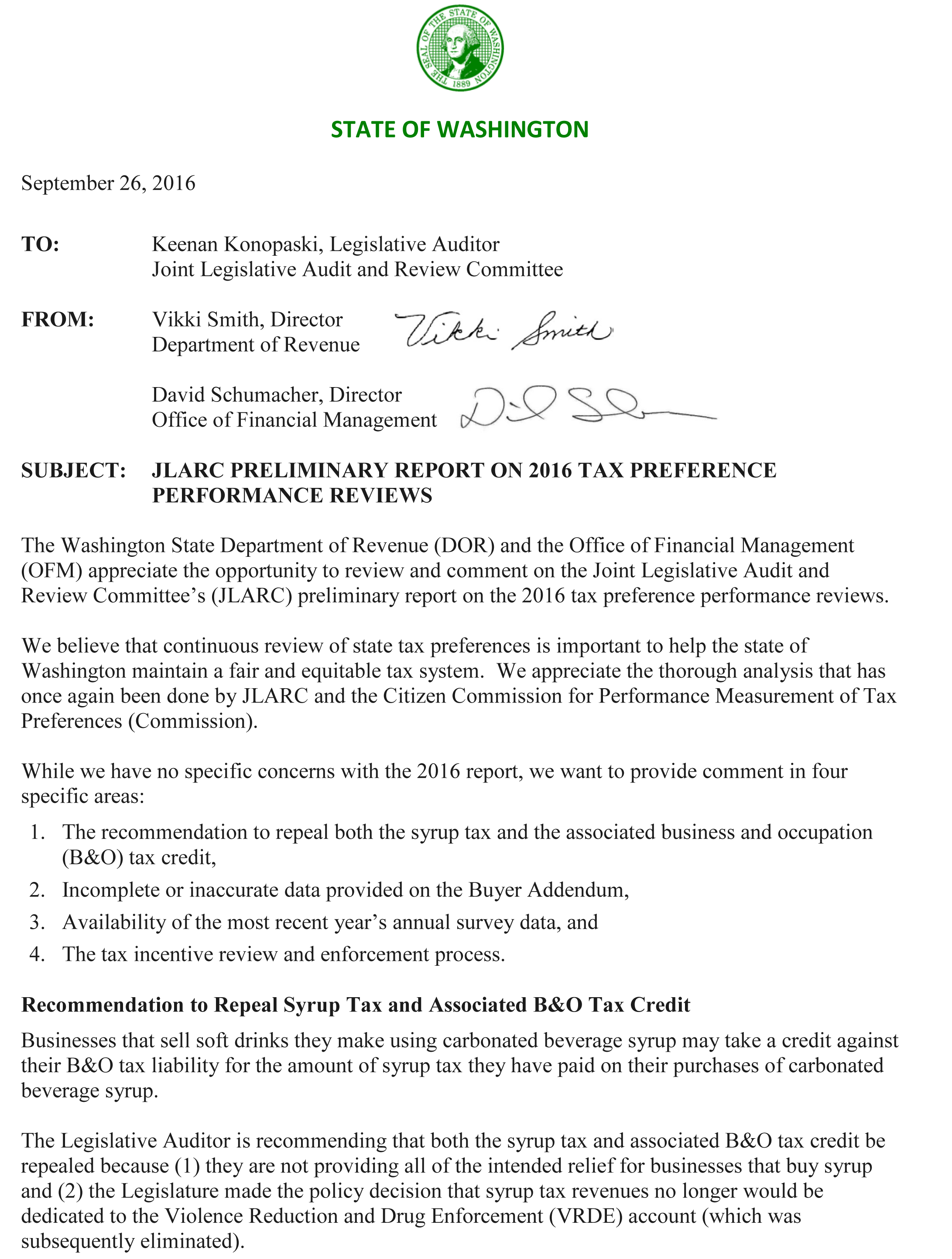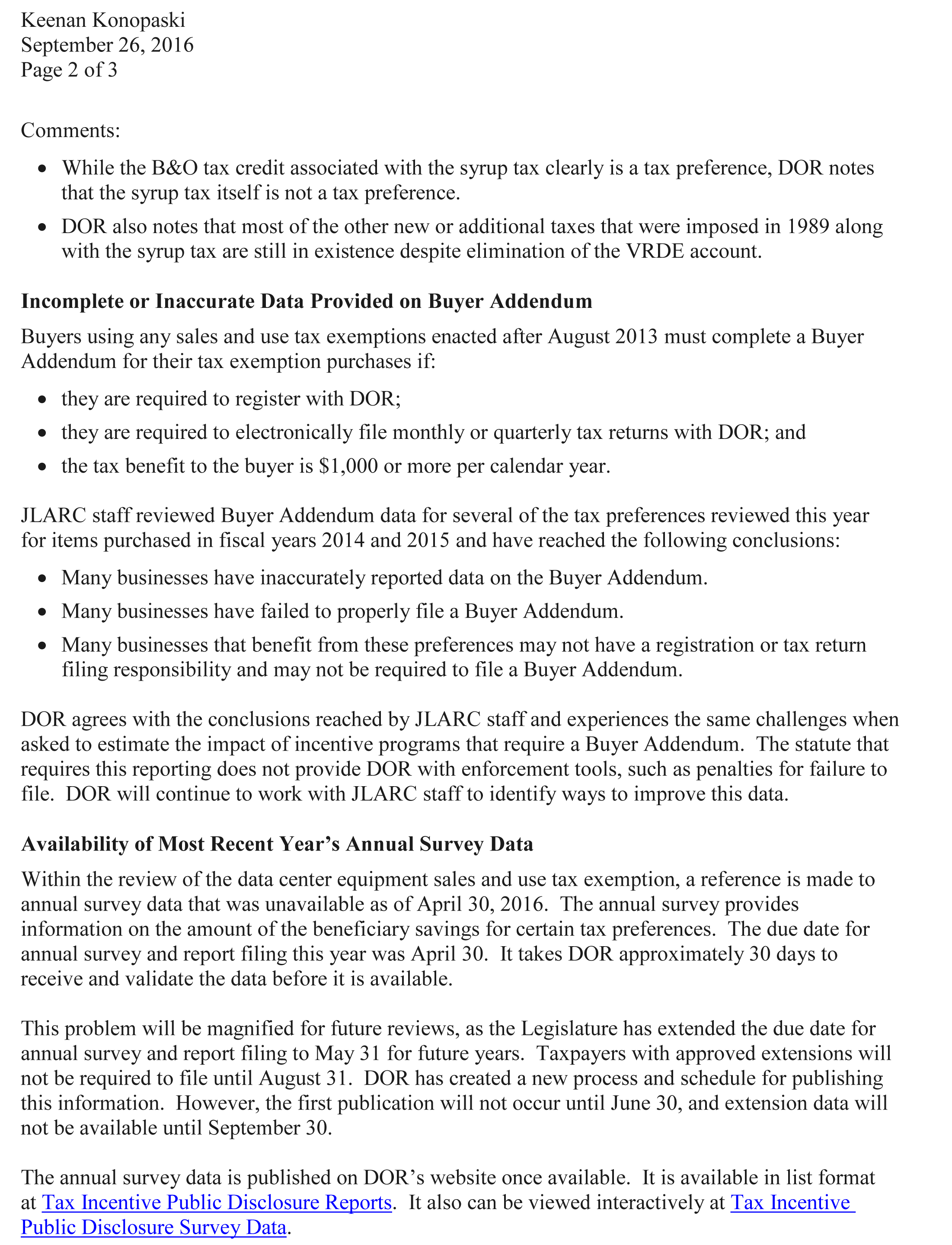An updated version of this report is available.
| The Preference Provides | Tax Type | Estimated Biennial Beneficiary Savings |
|---|---|---|
| A sales and use tax exemption for buyers of custom software and customization of prewritten software.
Sellers of custom software and customization of prewritten software are subject to the service B&O rate of 1.5 percent, rather than the retailing B&O tax rate of 0.471 percent. The preference has no expiration date. |
Sales & Use Tax RCWs 82.04.050 (6)(a)(i)-(ii) |
$269.3 million |
| Public Policy Objective |
|---|
| When enacting the tax preference in 1998, the Legislature stated the public policy objective is to make the tax treatment of software clear and certain for developers, programmers, and consumers. The Legislature found that certainty of tax treatment is essential to the industry and consumers. This preference was enacted prior to the Legislature’s requirement to provide a performance statement for each preference. |
| Recommendations |
|---|
|
Legislative Auditor’s Recommendation
Continue: The Legislature should continue the custom software tax preference because it is achieving the stated public policy objective of making the tax treatment of software clear and certain for developers, programmers, and consumers. Commissioner Recommendation: The Commission endorses the Legislative Auditor’s recommendation without comment. |
The Legislature established this preference to make the tax treatment of software clear and certain for developers, programmers, and consumers.
Because purchases of custom software and customized prewritten software are excluded from the definition of a “retail sale,” buyers do not pay sales or use tax on the following two types of purchases:
The taxation of custom software and customized prewritten software has varied over time, in large part due to whether the purchase of the software was considered a “retail sale.”
Defining a purchase as a “retail sale” affects taxation in two ways. For the buyers of software, defining purchases as a retail sale means they have to pay sales or use tax. For the sellers of software, defining the sales determines what business and occupation (B&O) tax rate the software businesses pay.
If software sales are considered retail sales, the software sellers pay at a lower retailing B&O rate of 0.471. If software sales are considered sales of services rather than retail sales, the software sellers pay at the higher B&O service rate of 1.5 percent.
In 1979, the Department of Revenue (DOR) issued an Excise Tax Bulletin to address the taxability of different types of software.
The tax treatment of software depended on whether it was considered ‘custom’ or ‘prewritten,’ and these determinations were made based on the facts of individual cases. For example,
For the first time, the Legislature included computer services, such as computer programming and design, as a selected business service under the B&O tax. This meant that sellers of custom software had to pay the higher B&O service tax rate on any sales of custom software.
DOR continued to treat the customization of prewritten software as a retail sale. Buyers were subject to sales tax on their purchases, and sellers paid the lower B&O retail tax rate.
Between 1995 and 1996, DOR formed and chaired a group that included representatives from the software industry to consider rules on the taxation of software. The committee developed draft legislation that provided an explicit statutory framework for the taxation of software, specifying that prewritten software is tangible personal property, subject to sales tax, while the creation of custom software and modifications to prewritten software are services not subject to sales tax.
The Legislature stated it established this preference to make the tax treatment of software clear and certain for developers, programmers, and consumers.
The preference amended the definition of “sale at retail” to exclude “custom software” and “the customization of canned [prewritten] software.” The governor vetoed a section of the legislation that would have provided a B&O tax credit for software businesses that have their principal place of business in a distressed county.
The Legislature amended statute to change references to “canned” software to “prewritten computer” software as part of the statute implementing the Streamlined Sales and Use Tax Agreement.
The Legislature amended the definition of prewritten software as part of legislation concerning the taxation of certain products and services provided or furnished electronically. The amendments did not substantively change the tax preference.
Owners of custom software and customized prewritten software do not have to pay personal property taxes on these software programs. The underlying prewritten software is subject to personal property taxes.
DOR estimates this property tax preference will save beneficiaries approximately $4.8 million in state tax and $22 million in local tax in the 2015-2017 Biennium. DOR provided information for an expedited review of this tax preference in 2014.
When enacting the tax preference in 1998, the Legislature stated the public policy objective is to make the tax treatment of software clear and certain for developers, programmers, and consumers. The Legislature found that certainty of tax treatment is essential to the industry and consumers. This preference was enacted prior to the Legislature’s requirement to provide a performance statement for each preference.
The objective of making tax treatment clear and certain is being met because the statutory language governing the tax preference clarifies that the sale of both custom software and the customization of prewritten software are excluded from the definition of “sale at retail.” The statute states that this business activity is considered a service, and sellers of the software must pay the B&O service tax rate on their customization services.
DOR has indicated there have been few incidences of misinterpretation or misclassification of taxes related to custom or customized prewritten software since the preference was enacted.
As long as the preference language continues to clearly state the tax treatment of custom software and customized prewritten software, the preference will continue to meet its policy objective.
The direct beneficiaries of the tax preference are buyers of custom software and customized prewritten software because these consumers do not pay sales or use tax on such purchases.
Indirect beneficiaries are businesses that create and sell custom software and that customize prewritten software. These sellers may benefit from increased sales because buyers of their products are excluded from paying sales tax on their purchases. Also, while sellers must pay a higher service B&O tax rate, they might be able to pass a portion of the tax on to consumers.
The businesses who are indirect beneficiaries of this preference are primarily from the custom computer programming industry rather than Washington’s larger software publishing industry. The software publishing industry employs more than three times as many people in Washington as the custom computer programming industry.
JLARC staff estimate that direct beneficiaries saved $86.8 million in Fiscal Year 2015 and will save $269.3 million in the 2017-19 Biennium.
|
Fiscal Year |
Estimated State |
Estimated Local |
Estimated Total |
|
2014 |
$61,200,000
|
$22,600,000
|
$83,800,000
|
|
2015 |
$63,400,000
|
$23,400,000
|
$86,800,000
|
|
2016 |
$85,600,000
|
$33,000,000
|
$118,600,000
|
|
2017 |
$89,500,000
|
$34,500,000
|
$124,000,000
|
|
2018 |
$93,700,000
|
$36,100,000
|
$129,800,000
|
|
2019 |
$100,700,000
|
$38,800,000
|
$139,500,000
|
|
2017-19
Biennium |
$194,400,000
|
$74,900,000
|
$269,300,000
|
While direct beneficiaries of the preference do not pay sales or use tax for their purchases, the sellers of custom or customized prewritten software must pay a higher B&O service tax rate of 1.5 percent. From a state perspective, the B&O revenue gain partially offsets the loss of sales tax revenue.
Additional B&O tax revenue from sellers lowered the net impact of the sales tax loss to the state by an estimated $10.1 million dollars in Fiscal Year 2015 and an estimated $34.1 million in the 2017-19 Biennium.
|
Fiscal Year |
Estimated B&O Tax
Revenue Gain |
Estimated State Sales Tax
Revenue Loss |
Estimated Net Revenue Impact to State |
|
2014 |
$9,700,000
|
($61,200,000) |
($51,500,000) |
|
2015 |
$10,100,000
|
($63,400,000) |
($53,300,000) |
|
2016 |
$15,200,000
|
($85,600,000) |
($70,400,000) |
|
2017 |
$15,900,000
|
($89,500,000) |
($73,600,000) |
|
2018 |
$16,800,000
|
($93,700,000) |
($76,900,000) |
|
2019 |
$17,300,000
|
($100,700,000) |
($83,400,000) |
|
2017-19
Biennium |
$34,100,000
|
($194,400,000) |
($160,300,000) |
Buyers of custom or customized prewritten software would pay sales tax on their purchases. At the same time, sellers of the same custom software would pay a lower B&O retail tax rate of 0.471 percent rather than the service B&O tax rate of 1.5 percent. The net impact to the state would be an estimated increase in revenue of $160.3 million in the 2017-19 Biennium.
The extent to which this change might impact the sale of custom or customized prewritten software, and the effect on overall employment and the economy, is unknown.
Of the 45 states with a sales tax, Washington is consistent with 35 other states that exempt the sale of custom software from sales tax. The remaining nine states, Connecticut, Hawaii, Mississippi, Nebraska, South Carolina, South Dakota, Tennessee, Texas, and West Virginia, tax such sales.
Of the 36 states (including Washington) that exempt custom software from sales tax, 35 also exempt the customization of prewritten software. Of these states:
Virginia exempts custom software but not customized prewritten software.
The legislature finds that the creation and customization of software is an area not fully addressed in our excise tax statutes, and that certainty of tax treatment is essential to the industry and consumers. Therefore, the intent of this act is to make the tax treatment of software clear and certain for developers, programmers, and consumers.
"Sale at retail," "retail sale."
(1)(a) "Sale at retail" or "retail sale" means every sale of tangible personal property (including articles produced, fabricated, or imprinted) to all persons irrespective of the nature of their business and including, among others, without limiting the scope hereof, persons who install, repair, clean, alter, improve, construct, or decorate real or personal property of or for consumers
(6)(a) The term also includes the sale of prewritten computer software to a consumer, regardless of the method of delivery to the end user. For purposes of (a) and (b) of this subsection, the sale of prewritten computer software includes the sale of or charge made for a key or an enabling or activation code, where the key or code is required to activate prewritten computer software and put the software into use. There is no separate sale of the key or code from the prewritten computer software, regardless of how the sale may be characterized by the vendor or by the purchaser.
(b) The term "retail sale" does not include the sale of or charge made for:
(i) Custom software; or
(ii) The customization of prewritten computer software.
(c)(i) The term also includes the charge made to consumers for the right to access and use prewritten computer software, where possession of the software is maintained by the seller or a third party, regardless of whether the charge for the service is on a per use, per user, per license, subscription, or some other basis.
(ii)(A) The service described in (c)(i) of this subsection (6) includes the right to access and use prewritten computer software to perform data processing.
(B) For purposes of this subsection (6)(c)(ii), "data processing" means the systematic performance of operations on data to extract the required information in an appropriate form or to convert the data to usable information. Data processing includes check processing, image processing, form processing, survey processing, payroll processing, claim processing, and similar activities.
The Legislature should continue the custom software tax preference because it is achieving the stated public policy objective of making the tax treatment of software clear and certain for developers, programmers, and consumers.
Legislation Required: No
Fiscal Impact: None


The Commission endorses the Legislative Auditor’s recommendation without comment.



